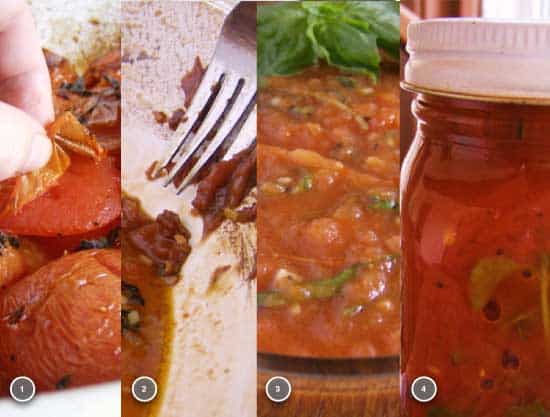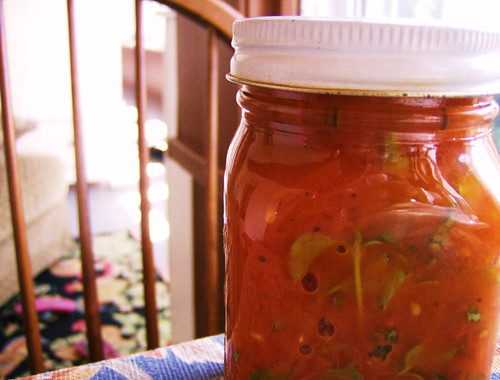I hauled 50 pounds of tomatoes out of my garden last week, and as I look out on this morning in the middle of September, I see another 100 pounds looking back at me. It has been an epic gardening year, and I feel fortunate to have had such success after such a difficult season in 2009. Now, a few years ago, I would have felt the panicky pressure about getting these tomatoes out of the field and into the pantry. But a few years ago, I started utilizing a different method with many of the items I can—tomato sauce, apple and pear sauce, etc.—that has all but eliminated the drudgery of the harvest season: oven roasting. And indeed, oven roasting can enhance many of our favorite garden finds, both taste- and health-wise.
There are several significant advantages to roasting that are worth noting for every home cook.
Taste
Driving water out of a watery product like tomatoes gives the final dish a concentrated, tomatoey flavor, just as adding less milk to your chocolate syrup makes your chocolate milk chocolatier. More intense flavors make us more satisfied as we eat; in fact, it’s one of the secrets to making your food taste like restaurant food. Oven roasting fruits and vegetables at high heat often produces the chef’s ultimate goal: the fond or browned bits and glaze in the pan or on the item that is a result the food’s natural sugars being caramelized by the heat. It’s the same stuff that lives in the bottom of your Thanksgiving turkey pan that you turn to gravy; and, like turkey fond, vegetable and indeed fruit fond can add a remarkable richness to your food.
Health
Studies show that the majority of nutrients in many fruits and vegetables are located just under the skin. Roasting skin-on fruits and vegetables, therefore, can often result in healthier final products. Along the same lines, many vitamins such as A, D, E, and K are fat-soluble vitamins—meaning they’re absorbed when combined with fat in your intestine, and these important vitamins are not destroyed by heat during the cooking process. So when good sources of these nutrients are roasted with a bit of olive oil for flavor, they’re also becoming more bio-available to your body.
Additionally, by avoiding boiling in large quantities of water, you’re avoiding losing vast quantities of water-soluble vitamins that are often destroyed by heat or leached into the cooking water and thrown out as you drain the food.
Because oven roasting concentrates the natural flavors of the food, you’ll find that you’ll be reaching for the salt and sugar much less. Since the high heat cooking method removes much of the water, the water can no longer dilute the natural sugars and sodium that naturally exists within the food.
Ease
But let’s just get down to the real benefit: ease. Oven roasting is often easier than other methods of cooking. Because the intense heat of the oven causes steam to build up between the skin and pulp of the fruits you’re cooking, you don’t have to peel them: just grab the peels and pull after they’re out of the oven. Also, when making a tomato sauce like the recipe I’ve developed below, you can avoid the long, drawn-out process of reducing down a fresh tomato sauce to remove the water and concentrate the flavors. You don’t have to watch a pot so it doesn’t burn.
Try oven roasting any vegetable you like, from asparagus to broccoli to sweet potatoes. Default to a bit of olive oil, salt, and pepper to start, and then add seasonings as you wish. Most veggies can roast at 400˚ until they’re crisp-tender and slightly browned. Fruits are great oven roasted as well: peaches, pears, and even lightly-sugared berries are amazing when served over ice cream or frozen yogurt.
My recipe for Roasted Tomato Sauce, below, demonstrates all of the benefits that oven roasting can provide: it’s easy, it’s fast, and it’s nutritious. It’s versatile because, depending on the texture you choose, it can be anything from a pizza topping to a soup. And it’s delicious. The roasting concentrates the tomato flavors, and by rubbing a tomato along all the brown scrumptiousness that forms during baking, you release all of the caramelized flavors that add richness to your sauce.

Roasted Tomato Sauce
Start with scratch for the most amazing tomato sauce! Stoneware or enameled cast iron is best for this recipe, but any non-reactive (i.e., not plain cast iron or light-colored aluminum) will work fine. The additions of fresh basil leaves and a bit of fresh orange juice brighten all of the flavors and balance the deep taste of the roasted tomatoes.
Servings: 8 (249 g )
Prep Time: 30 min.
Cook Time: 1 hour 30 min.
Ingredients
- 4 lbs. plum tomatoes, halved and seeded
- ½ red bell pepper, seeded
- 2 Tbsp. olive oil
- 3 cloves garlic, chopped
- 3 Tbsp. fresh oregano
- 1½ tsp. salt
- 1 tsp. pepper
- ¼ tsp. crushed red pepper
- ½ cup chopped fresh basil
- 2 Tbsp. orange juice
Directions
- Preheat oven to 425ºF. Toss the tomatoes and pepper with olive oil, garlic, oregano, salt, pepper, and crushed red pepper. Arrange in a single layer, skin side up, in a large baking dish and roast until skins are brown and blistered (30-40 minutes).
- Remove the pan from the oven and allow to cool slightly (20-30 minutes). Remove as much of the skins as comes off easily. Deglaze the roasting pan, if desired, by using a fork to rub a piece of tomato along any brown bits that formed on the pan during roasting.
- Mash the tomatoes to desired texture, using a fork for chunky sauce or a food processor for a smoother sauce. Stir in the basil and orange juice and serve as desired.
About the Expert Chef
Erin Dow balances three food worlds. As a mother of three young children, she’s fighting the battle every parent faces: how to keep her kids interested in the foods that keep them healthy.
As the chef and owner of her catering company Eatswell Farm, she utilizes original recipes and techniques–focused on enhancing the enjoyment of locally-sourced ingredients–to best interpret the client’s vision. And as Consulting Executive Chef for Falmouth-based Professional Catering Services, a business specializing in production and backstage catering for concerts, she develops and executes menus that accommodate the strict nutritional requirements of the music industry elite.
Erin and her family raise their own chicken for meat and eggs, have dabbled in pastured Narragansett turkeys, and have a very weedy but very large and productive garden.
